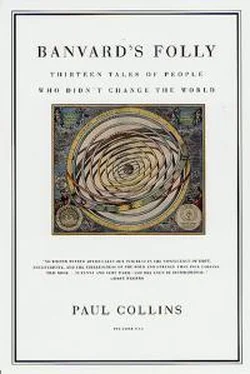Langmuir's remarks weren't published until October 1989, when Physics Today transcribed an old wire recording of the speech. The date of their reprint is not accidental: it was the precise moment at which cold fusion was imploding.
Wood never identified Blondlot in his article for Nature, and Physics Today didn't mention Pons and Fleishmann in theirs. Readers knew.
Beneath this tale of self-delusion, though, there is another and more troubling story. That Blondlot suffered a sort of madness toward the end is obvious: how else could he be seeing spectral wavelength lines after Wood had removed the aluminum prism? But before the heady rush of publicity and fame, before n-rays even had a name, back on that otherwise ordinary day in the winter of 1903 ... what had made him see that first fatal flicker in his spark detector apparatus? He hadn't even been looking for a new form of radiation, after all--he was simply experimenting with X-rays.
What led such a good scientist astray?
The answer, perhaps, can only be glanced at out of the corner of the eye. The first clue to Blondlot's downfall is contained the last page of his own book on the subject, n-Rays:
It is indispensable in these experiments to avoid all strain on the eye, all effort, whether visual or for eye accommodation, and in no way to try to fix the eye upon the luminous screen whose variations in glow one wishes to ascertain. On the contrary, one must, so to say, see the source without looking at it, and even direct one's glance vaguely in a neighboring direction.
In other words, to see n-rays, you had to look slightly away from the light source. And this was how Blondlot, a careful empiricist working with reliable instruments, had first seen the effect of n-rays on his test apparatus.
There was just one problem: the human eye is not a reliable instrument. It had been long known to astronomers that peripheral vision has some very strange effects on perception. In his 1832 book Letters on Natural Magic, the scientist David Brewster wrote:
It is a curious circumstance, that when we wish to obtain a sight of a very faint star, such as one of the satellites of Saturn, we can see it most distinctly by looking away from it, and when the eye is turned full upon it, it immediately disappears.
This anatomical curiosity was probably not widely known to physicists like Blondlot or Charpentier--after all, that wasn't their field of study.
But lost amid the ebullient shouting out of n-ray discoveries in hundreds of science journal articles in 1904 was a Nature piece on optics and n-rays, a translation of a speech by German physicist Otto Lummer, that excited little
commentary among physicists. They would have done well to read their magazines more carefully. In Nature's February 18 issue, long before anyone else, Lummer had deduced that the key to understanding n-rays was the fact that they could only be viewed obliquely:
A whole set of Blondlot's experiments may be almost exactly imitated in their effects without employing any source of illumination whatsoever, and ... the changes ... may be referred to the contest between the rods and cones of the retina in seeing in the dark.
In the human eye, rods perceive in black and white, while cones perceive color. The rods have a much lower threshold for stimulation; that's why at nighttime, when light is limited, cones become inactive and the world seems to lose color.
The center of the eye is dominated by cones, while rest of the retina has a combination of rods and cones. This makes good evolutionary sense. You make distinctions of color by staring directly at an object, while minor gradations in light intensity--the shadows and light caused by movements of, say, a sabertooth tiger stalking up behind you at night--are more quickly perceived by the sensitive rods in your peripheral vision. This clever structuring of the eye also results in the odd quirk observed by Brewster and other astronomers so many years before, says Lummer:
Being accustomed to gaze at what sends us light, we turn our eyes in the direction from which the rays come. As, however, the cones have not yet been stimulated ... we cannot see the spot gazed at. Thereby we are confronted by the remarkable fact that we see something which we are not gazing at, whilst it becomes invisible when we wish to fix our eyes upon it.
Likewise, a faintly visible light like a dim spark or phosphorescent screen can appear to become slightly brighter when viewed indirectly. The actual light source hasn't become any stronger; it's just that viewing something from periphery makes it cross a threshold of perception within the eye, by stimulating more rods than it would when stared at directly.
The great tragedy of Renè Blondlot is that on that fateful day in his lab in 1903, he had seen sparks and phosphorescent screens brighten out of the corners of his eyes. But he wasn't seeing a change that reflected an external reality; the excess light only existed in a ghostly electrical impulse along his own optic nerve. And so, in a sense, his critics were right all along.
It really was all in his head.
IF ONLY GENIUSES KNEW HOW TO SCHEME
Imagine for a moment a universal language: translatable to color, melody, writing, touch, hand signals, and endless strings of numbers. Imagine now that this language was taught from birth to be second nature to every speaker, no matter what their primary language. The world would become saturated with hidden meanings. Music would be transformed, with all the instruments in the orchestra at an opera engaged in simultaneous dialogue: cellos darkly muttering melancholy comments about the protagonist while the French horns wonder aloud about the unlikely plot, and oboes informing the audience of a sponsor's prix fixe menu. People could, through hand signals, hold conversations across the balcony seats, allowing them to silently critique the contralto.
The rise and fall of voice in a conversation could carry a subtext, with the internal melody of speech expressing an entirely opposite or hidden sentiment.
Skilled speakers could employ a sort of musical counterpoint to their words, with meanings running in parallel, or in contrast, and commenting parenthetically upon their own words even as they uttered them.
Textiles would be elaborate documents, actual texts again. The variegated strands of color in curtains, rugs, and dresses would reveal, upon inspection, entire hidden passages of literature. Numbers would become a language in and of themselves, whether through telegraphic taps or through details as mundane as the pattern of nails across floorboards, rivets in beams, or the arrangement of phone numbers--all would hold a thought frozen within them.
Many attempts to radically change language are inside jobs. After all, when we reach for our Webster's Dictionary, we may not realize that we are grabbing a piece of linguistic propaganda. Webster's is little more than a reference work today, but it was not always such. Noah Webster wrote with an explicit theological intention in mind, for he traced back the proliferation of human languages to Babel. The point of the dictionary maker was not to record language as it was used, but to direct language to how it should be--to simplify it, to return toward the Edenic universal tongue in which man, beast, and God could converse freely.
Yet even our greatest lexicographer's effort met with only modest success.
True, he changed "theatre" to the more sensible "theater," but he never persuaded the American public to spell "bread" as "bred," or "give" as "giv."
It was not for lack of trying--at one point Webster even published his own translation of the Bible, rendered in his own phonetic spellings. It went over about as well as a Bible in Ebonics might today. People were not prepared to dispense with their maddeningly illogical native tongues. Anything more than incremental change could come only from the creation of an entirely new universal language--a massive project that no human could undertake in one lifetime.
Читать дальше











